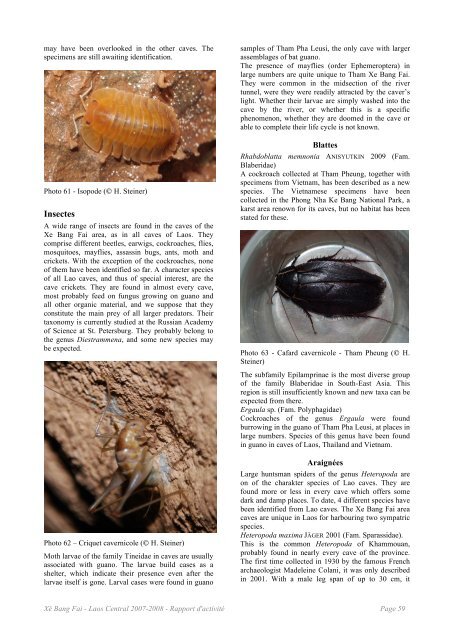EXPLORATIONS SPÉLÉOLOGIQUES EN RÉPUBLIQUE ...
EXPLORATIONS SPÉLÉOLOGIQUES EN RÉPUBLIQUE ...
EXPLORATIONS SPÉLÉOLOGIQUES EN RÉPUBLIQUE ...
You also want an ePaper? Increase the reach of your titles
YUMPU automatically turns print PDFs into web optimized ePapers that Google loves.
may have been overlooked in the other caves. The<br />
specimens are still awaiting identification.<br />
Photo 61 - Isopode (© H. Steiner)<br />
Insectes<br />
A wide range of insects are found in the caves of the<br />
Xe Bang Fai area, as in all caves of Laos. They<br />
comprise different beetles, earwigs, cockroaches, flies,<br />
mosquitoes, mayflies, assassin bugs, ants, moth and<br />
crickets. With the exception of the cockroaches, none<br />
of them have been identified so far. A character species<br />
of all Lao caves, and thus of special interest, are the<br />
cave crickets. They are found in almost every cave,<br />
most probably feed on fungus growing on guano and<br />
all other organic material, and we suppose that they<br />
constitute the main prey of all larger predators. Their<br />
taxonomy is currently studied at the Russian Academy<br />
of Science at St. Petersburg. They probably belong to<br />
the genus Diestrammena, and some new species may<br />
be expected.<br />
Photo 62 – Criquet cavernicole (© H. Steiner)<br />
Moth larvae of the family Tineidae in caves are usually<br />
associated with guano. The larvae build cases as a<br />
shelter, which indicate their presence even after the<br />
larvae itself is gone. Larval cases were found in guano<br />
samples of Tham Pha Leusi, the only cave with larger<br />
assemblages of bat guano.<br />
The presence of mayflies (order Ephemeroptera) in<br />
large numbers are quite unique to Tham Xe Bang Fai.<br />
They were common in the midsection of the river<br />
tunnel, were they were readily attracted by the caver’s<br />
light. Whether their larvae are simply washed into the<br />
cave by the river, or whether this is a specific<br />
phenomenon, whether they are doomed in the cave or<br />
able to complete their life cycle is not known.<br />
Blattes<br />
Rhabdoblatta memnonia ANISYUTKIN 2009 (Fam.<br />
Blaberidae)<br />
A cockroach collected at Tham Pheung, together with<br />
specimens from Vietnam, has been described as a new<br />
species. The Vietnamese specimens have been<br />
collected in the Phong Nha Ke Bang National Park, a<br />
karst area renown for its caves, but no habitat has been<br />
stated for these.<br />
Photo 63 - Cafard cavernicole - Tham Pheung (© H.<br />
Steiner)<br />
The subfamily Epilamprinae is the most diverse group<br />
of the family Blaberidae in South-East Asia. This<br />
region is still insufficiently known and new taxa can be<br />
expected from there.<br />
Ergaula sp. (Fam. Polyphagidae)<br />
Cockroaches of the genus Ergaula were found<br />
burrowing in the guano of Tham Pha Leusi, at places in<br />
large numbers. Species of this genus have been found<br />
in guano in caves of Laos, Thailand and Vietnam.<br />
Araignées<br />
Large huntsman spiders of the genus Heteropoda are<br />
on of the charakter species of Lao caves. They are<br />
found more or less in every cave which offers some<br />
dark and damp places. To date, 4 different species have<br />
been identified from Lao caves. The Xe Bang Fai area<br />
caves are unique in Laos for harbouring two sympatric<br />
species.<br />
Heteropoda maxima JÄGER 2001 (Fam. Sparassidae).<br />
This is the common Heteropoda of Khammouan,<br />
probably found in nearly every cave of the province.<br />
The first time collected in 1930 by the famous French<br />
archaeologist Madeleine Colani, it was only described<br />
in 2001. With a male leg span of up to 30 cm, it<br />
Xé Bang Fai - Laos Central 2007-2008 - Rapport d'activité Page 59


